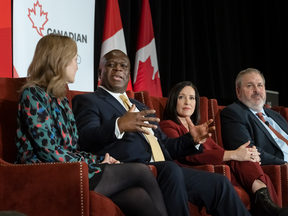Some economists aren’t convinced the government will be able to meet its goal
Article content
Canada’s population surpassed 41 million in April, just 10 months after it hit 40 million in June 2023.
The country added 242,673 people — mainly through immigration — in the first three months this year, Statistics Canada said on Wednesday. More than half the increase was due to temporary residents, such as students, foreign workers and asylum seekers.
Despite the rise, though, the agency expects the number of temporary residents to decline in the coming quarters because of the caps the federal government announced on non-permanent residents earlier this year. But some economists aren’t convinced the government will be able to meet its goal.
Advertisement 2
Article content
As Canada embarks upon cutting interest rates and loosening monetary policy, here’s what the latest immigration numbers mean.
The number of non-permanent residents living in Canada increased for the ninth quarter in a row to reach 2.8 million as of April 1. But Statistics Canada said the latest numbers may suggest a slowdown in the pace of the growth of temporary residents.
The 131,810 temporary residents added to the population in the first quarter is one of the “lowest quarterly net increases since higher levels of temporary migration began in the second quarter of 2022, the agency said.
Another reason it expects the growth to slow down is because the federal government in late March announced it would limit the number of temporary residents entering Canada to five per cent of the overall population during the next three years. Most of the growth in the first quarter predates that announcement.
“We may be starting to see signs of slowing in the coming quarters, which we don’t have data for yet, but with the announcement from (Immigration, Refugees and Citizenship Canada), that may be coming,” Stacey Hallman, an analyst at Statistics Canada’s Centre for Demography, said.
Article content
Advertisement 3
Article content
But Bank of Nova Scotia economists Rebekah Young and Anthony Bambokian aren’t so sure.
Canada’s overall population growth is “still going hot,” Bambokian said.
Young said the growth rate is trending stronger than last year and last year was a record-breaking one.
“We think it’s going to be really tough for them to reign in the numbers so dramatically in such a short time frame,” she said. “We are not seeing it in terms of data flows just yet.”
Government data from March suggests workers and students dominate the number of temporary residents in Canada. While 42 per cent of temporary residents are international students, about 53 per cent are on different work visa programs.
The number of study permits may be on the decline, but the work visa programs haven’t shown any signs of decreasing, economists say, which means that meeting the government’s target of a five per cent decline within three years could be difficult.
“The different policies and caps they set out still have to be enforced, especially on the worker visa sides, before we see any material changes in the numbers,” Young said.
Advertisement 4
Article content
Things seem a lot more straightforward in the permanent residency category. Canada aims to bring in about 500,000 permanent residents annually until 2026 and the numbers suggest it is on track to meet that target.
Later this year, the government is also expected to announce the exact number of temporary residents it aims to bring each year.
What does it mean for the economy?
The Bank of Canada earlier this month announced the first cut in interest rates in four years, and governor Tiff Macklem hinted there may be more cuts this year.
Young said the Bank of Canada will keep an eye on the strong population growth, which could be one of the upside risks.
There’s a “big debate” on whether population growth provides a “breathing space” from an inflation perspective or whther that “demand channel comes first,” she said. “On balance, we would probably say more people … is going to add more demand and the supply is a bit more lagged.”
How is Canada’s population tracked?
Statistics Canada counts the country’s population in two ways. The first is through the census, last published in 2021, which indicated there were about 925,000 non-permanent residents in Canada. That count takes place once every five years with households answering questionnaires.
Advertisement 5
Article content
The agency also provides quarterly and annual estimates of population growth. These estimates are based on post-census coverage studies of a representative sample of people to determine how many individuals were missed or counted more than once.
Who is a non-permanent resident?
Non-permanent residents include foreigners who either have a work or study permit in Canada or someone who has claimed refugee status. Family members of these persons are also included in this category unless they are already Canadian citizens, landed immigrants or permanent residents. People who enter Canada on a visitor visa are not included in this category.
Recommended from Editorial
-

Population tops 41M, but growth in temporary residents may be slowing
-

Here’s how Canada’s point system for skilled immigrants works
Non-permanent residents play an important role in the economy, according to Statistics Canada, since they fill critical labour shortages in key sectors, participate in the post-secondary education system and contribute as consumers.
• Email: nkarim@postmedia.com
Bookmark our website and support our journalism: Don’t miss the business news you need to know — add financialpost.com to your bookmarks and sign up for our newsletters here.
Article content
Canada’s population tops 41 million. Is this a rise before the fall?
2024-06-19 17:01:49







